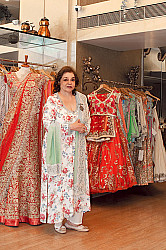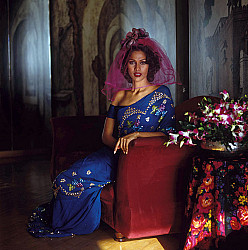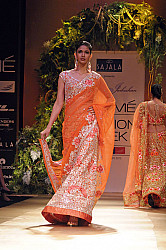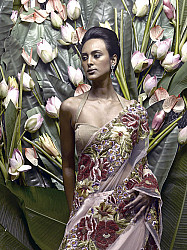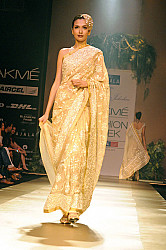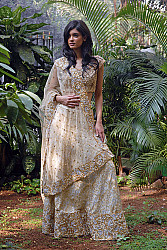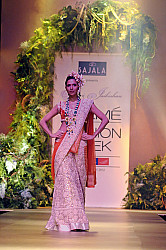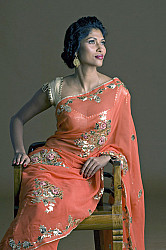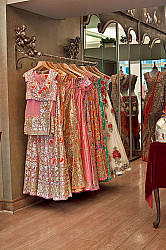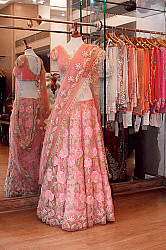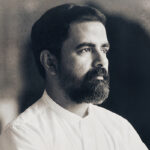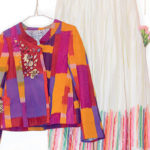Music and Roses
When comely Pallavi Mariwala, all of 19 years, eloped with composer Jaikishan (part of the famed Shankar-Jaikishan duo) it created quite a ruckus in her upper crust business family. “First of all he was much older (14 years) than me and then to make matters worse he was a filmi,” reminisces Pallavi, all peaches and cream and comfortable curves, as we walk down memory lane tracing her evolution as a designer. Why are we then talking about her romance? Because in this case, passion for her late husband and passion for her work are closely and intricately entwined – much like the detailed roses that embellish her couture. Because 40 years ago, when Pallavi Jaikishan lost the man she loved, she turned to the one thing she loved to do – embroidery. She sublimated her deep loss in intricate embroidery and craftsmanship. Even as she ached with loneliness, she dressed countless brides in fairytale ensembles dotted profusely with the symbol of love – the rose.
This year, even as Pallavi – now the doting grandmother of six – celebrates 40 years of her design journey, she is still very much a romantic at heart – as romantic as the teenager who braved her family’s wrath to tie the knot with the man of her dreams. Pallavi remembers the wonderfully hectic life she led as the wife of a much-feted music director and mother of three children – Chetan, Yogesh and Bhairavi. “I’d be busy from morning to evening – from 9 a.m. there would be music sittings, producers and lyricists would drop in, and this would go on till late at night. I was the perfect hostess – catering to everybody’s needs – tea, coffee, juice, impromptu meals…it was a hectic life and I loved every minute of it,” she smiles.
When did she start designing? “Well, since childhood, all the girls in the Mariwala family were expected to learn some craft or the other. In fact, the moment we returned from school, my grandmother would sit us down with a piece of embroidery, crochet, or sewing…so you can say the aesthetics of creating beautiful things was imbibed in me from a very tender age. Then later, when I accompanied my husband to film premieres or parties, I wore saris that I had designed and embroidered myself. I’d get showered with compliments by other ladies, including the heroines wanting to know where I’d got it all done!”
Pallavi may well have remained content embroidering her own saris, when tragedy struck. On September 12, 1971 the golden boy of Indian music, Jaikishan, passed away. “Eight years and 12 days of our marriage…and he was gone,” she says softly. “Bhairavi, our youngest child was just four and a half years old.” Pallavi herself was just 27.
The suddenness of his death shattered Pallavi. “When my children came from school they would see me crying and it affected them. However much I was hurting inside, I knew I had to put up a brave front for them. The children were used to this bustling home with people coming and going all the while. And suddenly there was nobody. They couldn’t understand the emptiness and I didn’t know how to explain it to them.”
She found solace in the one thing she knew well – embroidery. “My mother and mother-in-law were extremely supportive when I announced that I wanted to start designing on a commercial basis. In fact, within a week, my mother had found me a nice place on Pedder Road. And we named it Paraphernalia.” The present Paraphernalia is located but a few blocks away from where the first one used to be.
Was a decision to turn her innate craft into a commercial venture dictated by financial needs? “No,” she states emphatically. “He had left me well provided for, so that was not the issue. But I knew that if we had to maintain the lifestyle my children and I were used to, I too would have to bring something to the table.”
How she acquired her first clients is worth recounting in her own words. “We were staying in Govind Mahal, and the adjoining building Shree Niketan housed many Marwari families. Whenever we were entertaining, there would be lots of Peeping Janes, checking out the celebrities present,” she chuckles. However celeb spotting was not the only thing her inquisitive neighbours were doing – they were also checking out what Pallavi was wearing!
The first collection she showcased at Paraphernalia included not just saris, but table linen and, hand linen. “Whatever I could think of….” she says. Orders started pouring in and Pallavi Jaikishan, the designer, was in business. She worked from home initially, mainly to keep an eye on her children but as the children grew, so did her volume of business and within a few years she had shifted to a proper workshop in Parel.
In the ’80s, Pallavi began exporting exquisite beaded garments to renowned fashion and lifestyle stores across USA like Saks 5th Avenue, Lord and Taylor and Bergdoff Goodman. She also participated regularly in the Dusseldorf Fair and acquired an agent in Germany to handle all export orders in Europe. Pallavi was also one of the first designers in India, who realised the need for a prêt line and began retailing her prêt line in khadi and mulmul at the store Inter Plaza. Pallavi has no qualms about admitting that she is not a trained designer. “Look, I’ve always had a very strong sense of aesthetics. I have a passion for beauty and for creating beautiful things. You cannot become a designer by just attending some course, you have to have something within you.”
Her fondness for roses is well known and roses have almost become the leitmotif of her designs. “Well I do love roses, love all flowers, in fact. But this love for roses has turned into a Catch 22 situation for me – if I do roses, the critics pan me and if I don’t do roses my clients shun me,” she chuckles. Her designs are influenced by the classic – antique textiles, museums, paintings – and pure fabrics. “Fabrics that breathe and that can be comfortably worn in the Indian climate,” she says. And thus pure silks, chiffons and georgettes are perennial favourites in her collections.
Besides saris and lehengas, Pallavi is often asked to design menus and place settings, such is her reputation as a gourmet cook and inimitable hostess. “I love cooking. And though I’m a strict vegetarian, I learnt to cook non-vegetarian for my husband. And today I cook whatever my grandchildren want.” She goes on to share the recipe for kheema bhindi that was once her children’s favourite, and now her grandchildren’s too!
She recently took on the challenging assignment of designing embroidered upholstery for a prominent industrialist’s family home. “It was such fun,” she exclaims. “One room was art deco, one was totally French…and my upholstery had to reflect that era and ambience. For the guest bathrooms I did curtains with pure ghara embroidery.”
The fashion fraternity was stunned when she showcased her creations at the Lakme Fashion Week for the first time, this year in August. “Well I completed 40 years as a designer this April, and I wanted to celebrate this milestone by doing something new and this meant showcasing my work on as many different platforms as possible,” she explains. Pallavi showcased her traditional collection comprising Sajala – Clouds with a golden lining, Mandara – The mythical tree, Elavia – A thing of beauty and grace and Ayiana – The eternal bloom. Her collection essentially had saris and lehengas in shades of gold, green, rose pink, bright red and vermilion. “There were a lot of pure fabrics like silk and chiffon, even kota with pearl embroidery and burnished gold zari work. There were pastel colours and flower motifs with silver embellishments,” she says.
Was she ever forced to change her creative instincts to ‘play to the gallery’? “I would rather lose a client than compromise with my design aesthetics,” she emphasises. “I will always do classics, but certainly my design sensibilities have evolved over time. There are so many destination weddings today and what will work for a bride in India, will not work in Bali or Phuket, so obviously you have to take such factors into consideration without losing out on the essence of your own creative instincts. I was always into detailing, but now I’m afraid I’m getting obsessive over it.” To illustrate her point she shows me a sari where the rose is embroidered in shades tapering from red to blush.“I will not rest in peace till my karigars get this shading…this detailing… just right….”
Her children are settled in life, older son Chetan runs his own business of chocolates; Yogesh exports linen and designs and builds swimming pools; while daughter Bhairavi is a well-known fashion designer in her own right. Pallavi is content in her world, the only regret being that none of the children followed in their father’s footsteps and took to music.
But Pallavi keeps his legacy alive and personally answers all the fan mail that still comes for him. “I always attach an autographed picture or a biography of his works, or even music CDs.”
After 40 long years, her work is a testimony of the fact that each garment is designed and handcrafted exclusively by her. Her signature style remains to date subtle, elegant and sophisticated. And romantic much like the creator herself.
Related posts from Verve:
Verve Trending
Sorry. No data so far.
us on Facebook to stay updated with the latest trends

